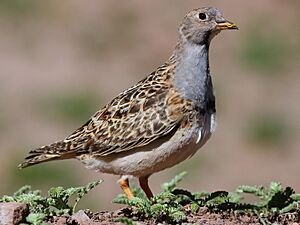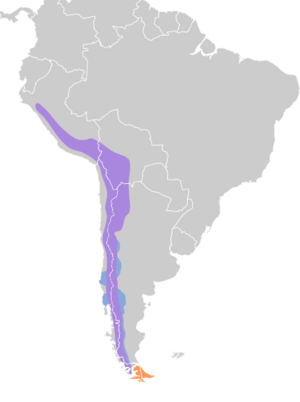Grey-breasted seedsnipe facts for kids
Quick facts for kids Grey-breasted seedsnipe |
|
|---|---|
 |
|
| Conservation status | |
| Scientific classification | |
| Genus: |
Thinocorus
|
| Species: |
orbignyianus
|
 |
|
The grey-breasted seedsnipe (Thinocorus orbignyianus) is a type of bird that belongs to the family Thinocoridae. You can find this bird in parts of Argentina, Bolivia, Chile, and Peru. It's known for living in high mountain areas.
Contents
About the Grey-Breasted Seedsnipe
The grey-breasted seedsnipe is a medium-sized bird. It is about 19 to 24 cm (7.5 to 9.4 in) long. This is roughly the length of a ruler. It weighs between 96 to 140 g (3.4 to 4.9 oz). That's about as much as a small apple.
Appearance and Colors
Male seedsnipes have a grey head, neck, and upper chest. Their throat is white with a black line around it. Their upper body has a cinnamon-buff color with wavy lines. These lines are called a vermiculate pattern. When they fly, you can see white stripes on their wings. Their lower chest and belly are white. A thin black band separates the white belly from the grey upper chest.
Female seedsnipes look a bit different. Their head and chest are a pale buff color. They have many dark streaks or stripes.
There are two slightly different kinds, or subspecies, of the grey-breasted seedsnipe. One is called Thinocorus orbigyianus orbigyianus. The other is T. o. ingae. They look very similar. However, T. o. ingae has slightly shorter wings and legs.
Where They Live and Their Home
The grey-breasted seedsnipe lives in the Andes mountains. One subspecies, T. o. ingae, lives from Peru down through Bolivia, northern Chile, and northwestern Argentina. The other subspecies lives from northern Chile and northwestern Argentina south into Tierra del Fuego.
These birds usually stay in their homes all year. But the ones in Tierra del Fuego move north during the winter. They also move up and down mountains depending on the season.
Their Mountain Home
The grey-breasted seedsnipe likes to live in Puna grassland. This is a type of high-altitude grassland. They prefer areas with low, matted plants or short grass. They often live near wet, marshy areas called bogs.
In Peru, you can find them very high up. They live between 3,400 and 5,000 m (11,200 and 16,400 ft) above sea level. That's higher than many clouds! Further south, they usually breed above 1,000 m (3,300 ft). But in the summer, they might be found lower down, even below 400 m (1,300 ft) in parts of Chile.
Seedsnipe Behavior
What They Eat
Grey-breasted seedsnipes are usually seen alone. Sometimes, you might spot them in small family groups. They like to eat the buds and leaves of small plants. They also eat juicy plants called succulent plants.
Reproduction and Life Cycle
These birds lay their eggs between October and February. They build their nests in clumps of grass or other plants. Their nests are usually close to water. A female seedsnipe typically lays four eggs at a time.
Their Calls and Songs
The grey-breasted seedsnipe has a special song. It sounds like a dove's call, a repeating "coocoop...coocoop...coocoop...". They sing this song from the ground. They also sing it during their display flights at dawn and dusk. When they are startled and fly away, they make a sound like a "snipe-like 'chrp'".
Conservation Status
The IUCN (International Union for Conservation of Nature) keeps track of how many animals are left. They have said that the grey-breasted seedsnipe is of "Least Concern". This means it is not currently in danger of disappearing.
There are an estimated 6,700 to 17,000 adult seedsnipes. Their numbers are thought to be stable. The areas where they live are often far from people. This means there isn't much human activity to bother them.


